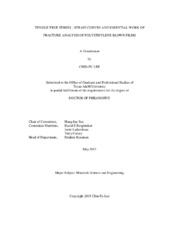| dc.description.abstract | Characterization of mode-I fracture toughness of ductile polymeric thin films is nontrivial. In order to gain understanding about the fracture mechanics and the processing-structure-property relationships of metallocene linear low-density polyethylene (m-LLDPE) thin film, a custom-built double-edge notched tensile (DENT) test fixture was developed to perform the mode-I fracture test on m-LLDPE thin films, and the essential work of fracture (EWF) analysis, which employs an unique energy partitioning concept, was used to characterize the fracture toughness of the thin films. Effects of specimen geometry, strain rate, film orientation, processing parameters, and resin densities on the specific essential work of fracture, we, and the specific non-essential work of fracture, wp, were investigated. The usefulness of the methodology incorporating the EWF analysis and the custom-built film fixture for characterizing LLDPE fracture toughness is evaluated and discussed, and the correlations between the EWF parameters and the films’ Elmendorf tear properties were also made. The visual, full-field stress distributions of the EWF film specimens were measured in-situ during mode-I facture testing by the photoelastic method, and the deformation in the process zone of post-mortem specimen was also characterized. A new experimental approach has been developed to directly quantify and partition the total mode-I fracture energy of m-LLDPE blown films. Three distinctive deformation zones have been identified from the photoelastic observation of the m-LLDPE blown films during the mode-I facture testing. These three zones include the essential work zone due to necking and crack propagation, the non-essential plastic deformation zone, and a newly proposed recoverable viscoelastic deformation zone. The tensile true stress-strain curves of m-LLDPE blown films and the full-field strain mapping of the mode-I DENT specimen were generated to allow for quantitative energy partitioning at each deformation zone in-situ as defined by the EWF approach. The current approach allows to perform directly quantification and partitioning of the total mode-I fracture energy for the exact physical interpretation of the EWF parameters and their correlation to material characteristics. | en |


